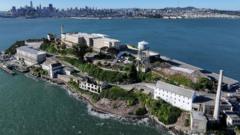The well-known Alcatraz prison, located on an isolated island in San Francisco Bay, served as a federal penitentiary until its closure in 1963 due to high operational costs and unsatisfactory facility conditions. Initially built as a military fort, it evolved into a maximum-security prison housing infamous criminals, including Al Capone and George "Machine Gun" Kelly. Post-closure, Alcatraz transformed into a popular tourist destination, attracting over 1.4 million visitors annually, derived from its storied past and cinematic fame.
Despite President Trump's vision of re-establishing Alcatraz as a symbol of law and order, experts argue it is unrealistic due to the extensive repairs required. Critics highlight that the prison's structure is deteriorating, with issues such as crumbling concrete and outdated infrastructure rendering it an unsuitable facility for modern incarceration needs.
Historically, proposals to reconsider Alcatraz for imprisonment have faced skepticism. Previous administrations have approached the idea, notably during the Reagan years, but ultimately opted against it due to the site's importance as a historical landmark and lack of adequate prison facilities.
Trump's plans began to circulate when he expressed the need for renewed law enforcement measures in a recent post on social media, stating, "for too long America has been plagued by vicious, violent, and repeat criminal offenders." However, former Bureau of Prisons officials, including Hugh Hurwitz, have voiced doubts, emphasizing the impracticalities associated with functional rehabilitation and stringent security measures needed for a modern prison.
Furthermore, logistical challenges present concerning essential utilities—such as water supply and sewage management—further complicate any potential reopening. With current per capita costs in federal prisons exceeding $120, a return to Alcatraz could exceed $500 per inmate, making it an economically burdensome proposition.
As the dialogue surrounding Alcatraz unfolds, it provides a unique lens into ongoing conversations about criminal justice, facility management, and the historical significance of incarceration sites in America. The overarching sentiment among historians and experts remains critical—the notion of reopening Alcatraz, while intriguing, appears more fantasy than feasible solution.
Despite President Trump's vision of re-establishing Alcatraz as a symbol of law and order, experts argue it is unrealistic due to the extensive repairs required. Critics highlight that the prison's structure is deteriorating, with issues such as crumbling concrete and outdated infrastructure rendering it an unsuitable facility for modern incarceration needs.
Historically, proposals to reconsider Alcatraz for imprisonment have faced skepticism. Previous administrations have approached the idea, notably during the Reagan years, but ultimately opted against it due to the site's importance as a historical landmark and lack of adequate prison facilities.
Trump's plans began to circulate when he expressed the need for renewed law enforcement measures in a recent post on social media, stating, "for too long America has been plagued by vicious, violent, and repeat criminal offenders." However, former Bureau of Prisons officials, including Hugh Hurwitz, have voiced doubts, emphasizing the impracticalities associated with functional rehabilitation and stringent security measures needed for a modern prison.
Furthermore, logistical challenges present concerning essential utilities—such as water supply and sewage management—further complicate any potential reopening. With current per capita costs in federal prisons exceeding $120, a return to Alcatraz could exceed $500 per inmate, making it an economically burdensome proposition.
As the dialogue surrounding Alcatraz unfolds, it provides a unique lens into ongoing conversations about criminal justice, facility management, and the historical significance of incarceration sites in America. The overarching sentiment among historians and experts remains critical—the notion of reopening Alcatraz, while intriguing, appears more fantasy than feasible solution.






















